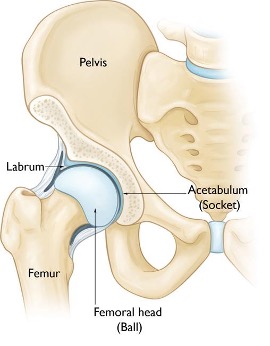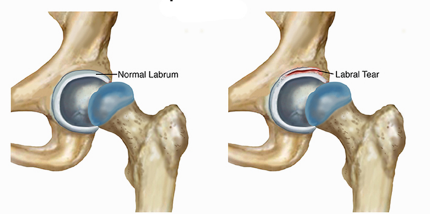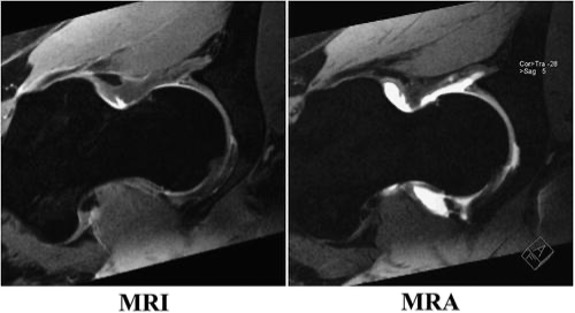The goal of this blog is to provide more guidance regarding hip labral tears and to bring clarity to those frustrated and without answers.
Let’s start with the anatomy of the hip joint!
The hip joint is a ball and socket joint made up of the head of the femur and the acetabulum of the pelvis that acts as a socket for the femur. Between the femur and acetabulum lies the labrum. The labrum is a type of cartilage that primarily functions to increase the depth of the socket, provide shock absorption, create stability, and act as a seal for the hip which further improves joint stability. The labrum also increases the joint surfaces by 22% and the volume of the joint by 33%.

What is a labral tear?
- Labral tears are often associated with cartilage damage near the tear, and/or femoral acetabular impingement (FAI), hypermobility, dysplasia, or degeneration, with FAI being the most common cause of a labral tear.
- FAI is characterized by deformity of the acetabulum, femoral head, or both and can present very similarly to hip labral tears.
- A tear in the labrum may result in instability, subluxation, or dislocation of the hip.
- Additionally, hip labral tears are reported as the cause of hip or groin pain in as many as 22-55% of patients and affect males and females equally and can present at any age.
- It should also be noted that if a torn labrum goes untreated, this can lead to premature osteoarthritis, therefore, it is essential to seek physiotherapy services and other additional health care channels (as explained below) to determine if you may be presenting with a labral tear in your hip!

How does a hip labral tear occur?
Labral tears can happen due to various reasons and in various settings.
- Repetitive trauma
- Isolated event
- Motor vehicle accident, falling with or without dislocating the hip, or slipping
- Sports that involve hyperextension or external rotation of the hip
- Ballet, soccer, hockey, golf, running, sprinting
Why can it be difficult to diagnose and treat hip labral tears?
The term ‘acetabular labral tear’ or ALT is a relatively new term in reference to hip pathologies. It was not too long ago in 1986 when the first non-traumatic hip labral tear was reported and discovered arthroscopically. Before this time, labral tears went unrecognized and untreated in the surgical field and likewise, with physiotherapists, labral tears were not a topic of discussion until the 1980’s and 1990’s.
Symptoms:
Commonly reported symptoms of a labral tear include the following:
- Anterior hip or groin pain that may refer to the buttock, thigh, medial knee, or outer hip region
- Clicking, locking, snapping, giving way/instability or stiffness
- Constant dull pain with intermittent sharp pain that increases with activities
- Symptoms are aggravated by walking, pivoting, prolonged sitting or running
- Night pain may be present
- Pain at extremes of range of motion
- E.g., stressing the hip joint in rotation
What to expect at a physiotherapy session?
During your initial interaction with a physiotherapist, you will have the opportunity to describe your symptoms, inform when symptoms started, how long you have been experiencing them, where they are located, and how they have impacted your quality of life and daily activities.
Once you have had the opportunity to explain your symptoms and presentation, the physiotherapist may ask you some more questions to help determine how and what they will test more objectively.
Some of the objective tests that the physiotherapist may perform may include
- Assessing your mobility, strength, and functional capacity.
- They may also perform a few more specific tests that can help determine if a labral tear may be present.
- Your physiotherapist may request imaging to get a better idea at what is going on within your hip joint and to highlight the potential need for surgical interventions. Magnetic resonance imaging (MRI) is commonly used to diagnose labral tears but is only 30% sensitive and 36% accurate and is known to produce both false-positive results and underestimate labral tears. However, magnetic resonance arthrography (MRA) produces better results and obtains more detailed images of the labrum with the use of a special dye called contrast. MRA is considered the gold standard test to evaluate labral tears and damaged cartilage in the hip joint and can therefore be used to confirm a hip labral tear diagnosis. Below is a picture of MRA of a hip labral tear.

Management
Labral tears can be managed non-operatively or operatively. Conservative treatment may be indicated and is usually tried for 10-12 weeks before considering operative interventions. Physiotherapists can provide the following:
- Education + counsel
- Activity modification + rest
- Modalities
- Individualized exercise programs that emphasize mobility, strength, and functional movement
- Manual therapy techniques
Other conservative interventions:
- Oral anti-inflammatory medications
- Intra-articular injections for therapeutic use OR diagnostic purposes
- Cortisone injections
- Steroid anti-inflammatory drug that helps reduce pain and inflammation
- Hyaluronic acid injections
- Gel-like substance naturally produced in the body that helps lubricate the joints is injected into the joint to reduce pain
- PRP (platelet rich plasma) injections
- Blood is drawn from the body and is highly concentrated with more platelets than typically found in the blood
- 5-10 x greater than the usual number of platelets
- Platelets contain proteins called growth factors that are important for healing injuries
- Blood is then injected into the hip joint to speed up the healing process
- For more information about PRP: https://www.youtube.com/watch?v=x_bJIvUgcSM&list=PLcE4KXxTU34gwsK0Y2zGFcLy98o3vrqf-&t=20s
- Blood is drawn from the body and is highly concentrated with more platelets than typically found in the blood
- Cortisone injections
Indications for Labral Repair:
Indicated if presenting with persistent symptoms and/or loss of function despite conservative approach to treatment for 10-12 weeks.
1. Hip Arthroscopy
- Hip arthroscopy is the primary surgical intervention used to repair a labral tear and is largely appealing due to its less invasive approach. Additionally, hip arthroscopy is used to determine if any bony impingement (FAI) is present and is then removed to help prevent recurrent tears. A small incision is made, and a small camera called an arthroscope is placed in the hip joint which displays video images while a surgeon guides surgical instruments into the hip joint to repair the labral tear. Patients tend to experience less pain, joint stiffness, and reduced recovery time due to this minimally invasive procedure.
2. Labral Reconstruction
- In severe cases or when the labrum cannot be fixed arthroscopically, labral reconstruction (making a new labrum with other tissue) may be considered.
- If you’re interested, here is a link to a video showing the hip arthroscopy procedure https://youtu.be/W_bIw_iSl8k
We are here to help!
We hope this blog has provided you with more clarity about your current hip complaints and that the information provided has been useful and informative. If you have any questions, feel free to reach out or book an appointment today.
Emily Clark, MScPT Student
REFERENCES:
- Burgess, R. M., Rushton, A., Wright, C., & Daborn, C. (2011). The validity and accuracy of clinical diagnostic tests used to detect labral pathology of the hip: a systematic review. Manual therapy, 16(4), 318-326.
- Hip Arthroscopy. OrthoInfo. https://orthoinfo.aaos.org/en/treatment/hip-arthroscopy/
- Huang, M. (2017, November 24). Diagnostic Hip Scope-Cartilage and labral tear . YouTube. https://youtu.be/W_bIw_iSl8k
- Labral Tear. Physiopedia. https://www.physio-pedia.com/Labral_Tear
- Martin, R. L., Enseki, K. R., Draovitch, P., Trapuzzano, T., & Philippon, M. J. (2006). Acetabular labral tears of the hip: examination and diagnostic challenges. Journal of Orthopaedic & Sports Physical Therapy, 36(7), 503-515.
- Orbell, S., & Smith, T. O. (2011). The physiotherapeutic treatment of acetabular labral tears. A systematic review. Advances in Physiotherapy, 13(4), 153-161.
- Platelet-Rich Plasma Therapy. Huang Orthopedics. https://www.huangortho.com/platelet-rich-plasma-prp-therapy
- Reiman, M. P., Thorborg, K., Goode, A. P., Cook, C. E., Weir, A., & Hölmich, P. (2017). Diagnostic accuracy of imaging modalities and injection techniques for the diagnosis of femoroacetabular impingement/labral tear: a systematic review with meta-analysis. The American Journal of Sports Medicine, 45(11), 2665-2677.
- Sport-Related Groin Pain. Dynamed. https://www.dynamed.com/approach-to/sports-related-groin-pain#HISTORY
- Su, T., Chen, G. X., & Yang, L. (2019). Diagnosis and treatment of labral tear. Chinese Medical Journal, 132(02), 211-219.
- Wong, S. E., Cogan, C. J., & Zhang, A. L. (2022). Physical Examination of the Hip: Assessment of Femoroacetabular Impingement, Labral Pathology, and Microinstability. Current Reviews in Musculoskeletal Medicine, 1-15.
